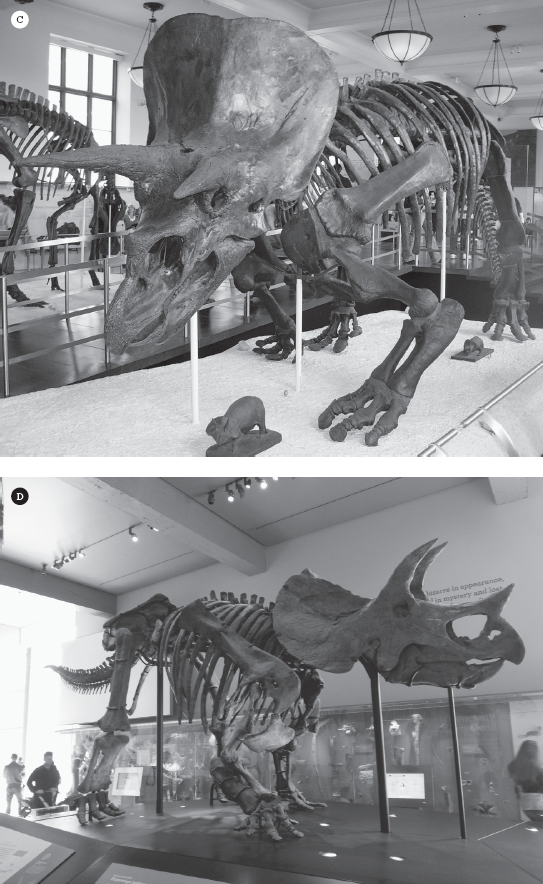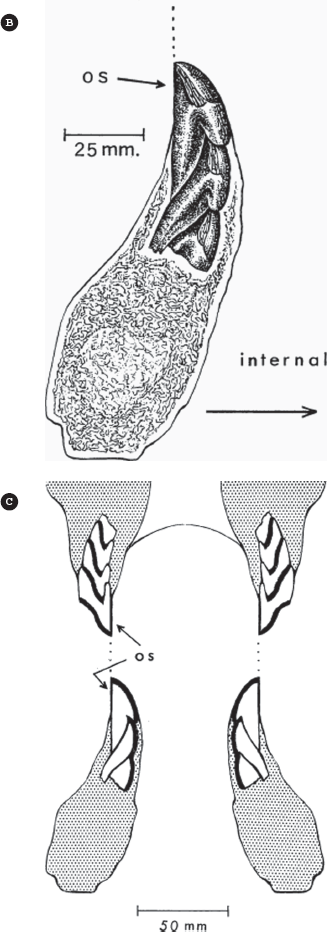A group of blind men heard that a strange animal, called an elephant, had been brought to the town, but none of them were aware of its shape and form. Out of curiosity, they said: “We must inspect and know it by touch, of which we are capable.” So, they sought it out, and when they found it they groped about it. In the case of the first person, whose hand landed on the trunk, said “This being is like a thick snake.” For another one whose hand reached its ear, it seemed like a kind of fan. As for another person, whose hand was upon its leg, said, the elephant is a pillar like a tree-trunk. The blind man who placed his hand upon its side said, “Elephant is a wall.” Another who felt its tail, described it as a rope. The last felt its tusk, stating the elephant is that which is hard, smooth and like a spear.
—THE BLIND MEN AND THE ELEPHANT, A HINDU PARABLE
THE BLIND MAN AND THE ELEPHANT
As with the history of so many early dinosaur discoveries, the story of Triceratops begins even before Edward Drinker Cope and O. C. Marsh and the Bone Wars. The first ceratopsian specimens were found in 1872, by Fielding Bradford Meek. Born in 1817 in Madison, Indiana, across the Ohio River from Louisville, as a boy Meek collected the abundant Paleozoic corals from the Falls of the Ohio between Louisville and Madison, and other invertebrate fossils all around southern Indiana. After failing in business, he tried his luck at science. He was hired to work for the U.S. Geological and Geographical Survey of the Territories in Iowa, and later for surveys in Wisconsin and Minnesota. Between 1852 and 1858 he was in New York, learning from pioneering paleontologist James Hall, who was the first to map the geology of New York and describe its fossils. On a break from that job, he joined Ferdinand Vandeveer Hayden’s Geological Survey of the Territories on his famous 1853 expedition to the Big Badlands of South Dakota and other areas. This expedition eventually provided lots of early mammal fossils for Joseph Leidy. In 1858, Meek moved to Washington, D.C. and worked full time compiling the reports and documents of the various early geological surveys of which he had been a part. In the 1860s, he was in California at the end of the Gold Rush, collecting fossils and publishing the first reports on the paleontology of California.
In 1872 Meek was in the Upper Cretaceous Laramie Formation in the Black Butte and Bitter Creek area of southwestern Wyoming, working with Henry Martyn Bannister, looking for fossil shells. These beds of terrestrial rocks were rich in dinosaurs (and a few freshwater mollusks), so they could not help but stumble upon dinosaur bone fragments. They were still working for the Hayden Survey, so they notified Cope of their finds. Cope got to Black Butte as soon as he could and found Meek’s site, which was full of huge bones protruding from the ground near a coal vein, with fossil sticks and leaves packed around it. He quickly rushed a short publication into print about the bones. He named it Agathaumas silvestris, and based the new genus on just 16 vertebrae from the back, hips, and tail, plus a partial pelvis and some ribs (figure 25.1). Agan means “much” and thauma means “wonder” in Greek, and sylvestris means “of the forest” in Latin, so it was the “great wonder of the forest.”
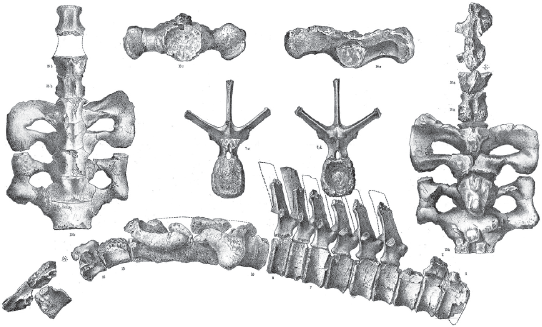
Figure 25.1
Cope’s original fragmentary fossils of Agathaumas silvestris, a genus based on a few vertebrae and hip bones. (From J. B. Hatcher, O. C. Marsh, and R. S. Lull, The Ceratopsia, 1907)
In 1873, Cope rhapsodized about the fossil as “the wreck of one of the princes among giants” because it was the largest land animal known anywhere in the world at that time. The huge stegosaurs and sauropods did not began to emerge from places in Colorado and Wyoming for several years, and the British dinosaurs Cetiosaurus and Pelorosaurus were still considered marine reptiles then (see chapter 3). As more fossils were found over the years, Cope added six additional species to Agathaumas; none are considered valid now because they were based on partial scrappy specimens with no diagnostic features that can be used today. Cope could not really tell what kind of dinosaur these bones came from, but he assumed it was from a hadrosaur as those were the only dinosaurs described in North America at that time.
One of these fossils was eventually reassigned to Monoclonius, which was found and named by Cope in 1876 when he and young Charles H. Sternberg were in the Judith River badlands of Montana looking for Late Cretaceous dinosaurs. They hastily collected the fossil (a short straight nose horn and part of the rounded frill) because the Battle of the Little Bighorn had recently ended about 150 kilometers (100 miles) to the east, and hostile warriors roamed the entire area. Assuming the hostiles would stay together for fear of counterattack from the U.S. Army, Cope persisted with his expedition. At one point, he was only a day away from Sitting Bull’s camp, and some of his local men deserted him. However, the only natives Cope’s crew saw were Crows, who were the enemies of the hostile Lakota (Sioux) and Cheyenne warriors found at Little Bighorn. They were impressed with Cope’s trick of removing his false teeth and reinserting them.
As more and more specimens of ceratopsians were found, it was clear that most of Cope’s Agathaumas fossils were nondiagnostic. With only the back end of the skeleton in the original specimen (figure 25.1), and without the skull and especially the horns, you can’t tell most ceratopsian dinosaurs apart. As much better specimens with skulls of Centrosaurus and Styracosaurus and eventually Triceratops were found, it was impossible to know where Cope’s fossils of Agathaumas belonged. Most paleontologists dropped the name, and it is nearly forgotten. To the end of his life, however, Cope refused to use Marsh’s names such as Triceratops, always insisting that his 1872 name Agathaumas had priority over the names of ceratopsians that were proposed later.
Unfortunately, Marsh’s first attempts at describing ceratopsian fossils were not much better than Cope’s. George M. Cannon and his crew were working for the U.S. Geological Survey in the Denver area in 1887, and they found fragmentary bones and a partial skull roof with two horns more than 60 centimeters (2 feet) long (figure 25.2). They came from the Laramie Formation, which we now know (and they also thought) were Cretaceous rocks. By this point, Marsh was the official paleontologist of the U.S. Geological Survey, so the fossils were sent to him to identify. Marsh thought they looked like enormous bison horn cores (figure 25.2), so he overruled the field men and even his own assistants and asserted that the fossils must have come from the younger Pliocene or Pleistocene beds in the area. Rushing to print, he named the fossils Bison alticornis (tall horned bison), and he wrote that it was “one of the largest of the American bovines, and one differing widely from those already described.” Like Cope, he had no idea that there was an entire family of horned dinosaurs because nothing like that had yet been found complete. Cope and Marsh were like the blind men and the elephant in the famous parable: each had different parts of the animal and jumped to false conclusions based on what was known of dinosaurs at the time.
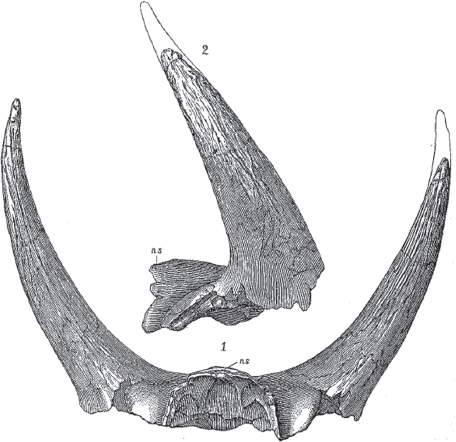
Figure 25.2
Marsh’s original fossils of “Bison alticornis,” based on horn cores attached to part of a skull. (From J. B. Hatcher, O. C. Marsh, and R. S. Lull, The Ceratopsia, 1907)
Within a few months of his “Bison alticornis” paper, Marsh received new fossils from John Bell Hatcher who was collecting in Cope’s old area in the Judith River badlands near Cow Creek, Montana, in the summer of 1888. These fossils consisted of a pair of horn cores and the back of the skull, but they were from known Cretaceous beds. Marsh suddenly realized that his “Bison alticornis” was a Cretaceous dinosaur after all. He called the horn cores Ceratops montanus, meaning “horned face from Montana.” From this name comes the name for the entire group, the Ceratopsia.
The name Ceratops hasn’t fared too well either because the broken horn cores were not diagnostic enough to really know what genus of horned dinosaur they represent. In 1906, Marsh’s successor at Yale, Richard Swann Lull, realized that the name Ceratops had already been used for a bird in 1815, so it was not available to be used on another animal. Lull wanted to rename the fossil Proceratops, but this was unnecessary. No one can tell where the fossil belongs, so Ceratops (like Agathaumas) is a nomen dubium, or “doubtful name.”
On the way home to Nebraska from collecting in Montana in late 1888, Hatcher made a stop in the Lance Formation north of Lusk in eastern Wyoming. He ran into the local rancher, Charles Gurney, whose cowboys told him they’d found a skull “with horns as long as a hoe handle and eye holes as big as your hat.” They had seen it sticking out of a bank just out of reach, lassoed it, and dislodged the horn and part of the skull, which then broke up as it fell into the wash. It was a nearly complete skull, with the paired horns over the eyes and the short nose horn and rostral beak in front. Hatcher told Marsh when he sent the broken horn that it had been attached to a massive skull embedded in a concretion and stuck in the bank of the creek. Marsh told Hatcher to go back and get the rest of the skull, which weighed more than a ton when finally collected. In May 1889, he wrote to Marsh, “The big skull is ours.” When Marsh received the specimen and described it in late 1889 (figure 25.3A), he named it Triceratops horridus (horrible three-horned face). Other specimens that he had been calling Ceratops were gradually reassigned to Triceratops.
Figure 25.3
(A) Marsh’s original type specimen of Triceratops horridus, the first partial skull retrieved by Hatcher. (B) Marsh’s reconstruction of Triceratops prorsus, based on the specimens known at the time. (C) The mounted skeleton of Triceratops horridus found by Barnum Brown in the Hell Creek beds of Montana, which is still on display today at the American Museum with its front limbs splayed out to the side like those of a sprawling alligator or a lizard. (D) A more modern reconstruction of Triceratops, with the front limbs held almost vertically beneath the body. ([A–B] From J. B. Hatcher, O. C. Marsh, and R. S. Lull, The Ceratopsia, 1907; [C] courtesy of Wikimedia Commons; [D] photograph by the author)
Hatcher spent the next four years (1889–1892) collecting mostly in the Lance Formation where Triceratops were everywhere. In that short time, he shipped more than 50 individual skulls and many partial skeletons to Marsh at Yale, and 33 of those were nearly perfect and unbroken. Some of these huge skulls weighed more than 3.5 metric tonnes (3.86 tons). By 1892, Triceratops was the best-known dinosaur of the time, with the largest sample of skulls found for any dinosaur. Even better more complete specimens were found in other Late Cretaceous localities, such as the Hell Creek Formation by Barnum Brown in 1902–1908; Triceratops was mounted and exhibited in the American Museum and other institutions (figure 25.3C). By the early twentieth century Triceratops was almost as familiar as Tyrannosaurus rex, and today it is an iconic dinosaur that everyone knows when they see it.
THE GAMBLER
The enormous quantity of Triceratops fossils found by Hatcher was fairly typical of his prowess as a collector and as a paleontologist.
Determined, confident, hard-working and often very temperamental, John Bell Hatcher was the most talented and respected field paleontologist of his generation, but he struggled mightily to find his own level in the hierarchical world of America vertebrate paleontology. (Brinkman, The Second Jurassic Dinosaur Rush, 123)
Hatcher was born a few months after the beginning of the Civil War, in October 1861, in Cooperstown, Illinois (figure 25.4). When he was very young, his family moved to Cooper, Iowa. There he became fascinated by the fossils he found lying on the ground all around him. He started his higher education in 1880 at Grinnell College in central Iowa. To earn money, he worked in the local coal mines and became intrigued with the beautifully preserved fossil plants he found. After just one term, he transferred to Yale’s Sheffield Scientific School, where he graduated in 1884. Just before graduating, he showed his fossil collection to the school’s mineralogist, George Jarvis Brush. Impressed with the young man’s enthusiasm, Brush introduced the 23-year-old college graduate to Marsh.
Figure 25.4
Portrait of John Bell Hatcher. (Courtesy of Wikimedia Commons)
Marsh needed a new young eager field assistant, so he sent Hatcher to Kansas to be trained by Charles H. Sternberg. (Cope was now broke and could not pay him, so Sternberg was now working for Marsh.) Sternberg wasn’t exactly excited to be training the young greenhorn, but he tried to be positive. He wrote that he “gave promise of a future even then by his perfect understanding of the work in hand and the thoughtful care which he devoted to it.”
The college-educated Hatcher, however, looked down on Charles H. Sternberg, especially his slapdash methods of getting the fossil out of the ground. Already trained in geology, Hatcher was a perfectionist, and he was interested in the details of the sedimentary rocks in which the fossils were found as a clue to their ancient environments, and how the fossil had died and become buried and fossilized (something most commercial collectors ignore even today). Hatcher wrote this about one of his finds:
On one side of a bone, the matrix will be made up entirely of sand, while on the opposite side the stem and leaves of plants have been dropped…. This…shows the direction of the current to have been from that side containing only sand, and towards the side containing the plants. So shallow were the waters, the bone itself became an obstacle sufficient to produce an eddy on the lower side, in which the leaves and other vegetable materials accumulated and sank to the bottom.
Sternberg helped Hatcher begin his training by collecting the hippo-like Miocene rhinoceros Teleoceras from Long Island Rhino Quarry in northern Kansas in 1885. Soon Hatcher was independent of Sternberg and reporting directly to Marsh. He roamed over much of the Rocky Mountain region collecting fossil mammals that he sent to Yale. In 1887, he married the sister of paleontologist Olof A. Peterson and settled in Nebraska. That summer he revisited some of Cope’s localities in Montana and sent a ton of bones back to Marsh. It was on the way home to his new bride that he made the discovery of the first good Triceratops skull roped by the cowboys in Lance Creek (figure 25.3A). That was the focus of his fieldwork for the next four years until 1892. In addition to all the Triceratops specimens, 1891 was highlighted by the discovery of the skull of Torosaurus, the longest skull that had ever been found in a land animal.
In 1889, Hatcher made the first-ever discovery of the teeth of Cretaceous mammals, which Marsh found extremely exciting. Hatcher stumbled on a technique used by many paleontologists since then—look at the anthills. In strata where there is nothing but muds and silts and fine sands and no gravel, the harvester ants will collect tiny, hard, gravel-sized objects like fossil teeth, creating an armored layer over the anthill to prevent it from blowing away. For more than a century, paleontologists have been abusing poor harvester ants by picking over the tops of their anthills, or scooping them away and running them through fine screen mesh to retrieve all the precious fossil teeth the ants have collected.
By this time, Hatcher was fed up with Marsh and his abusive ways. Marsh paid his collectors poorly, and he paid them infrequently as well. He insisted that Hatcher labor through the blizzards of the hard western winters rather than work in the museum on his finds of the previous year. More important, Marsh hogged all the credit for doing the work. He would not even give his assistants coauthorship on papers that they had written, putting his name over their writing. This had already driven Samuel Williston (who had started with Marsh in 1874) to leave in 1890 and start over in Kansas, becoming a professor at the University of Kansas.
Hatcher finally resigned in 1893 while he was still in the field. Osborn was aware of the discontent Marsh has fostered in his staff, and Osborn tried to recruit Hatcher for the American Museum paleontology program he was trying to build. Hatcher backed out, however, when he realized that Osborn himself didn’t have his own job secured yet. Hatcher got a job as a collector at Scott’s and Osborn’s alma mater, Princeton University, in 1893, through the invitation of Osborn’s friend William Berryman Scott. Osborn soon forgave him and helped him get established, even arranging for an honorary degree.
The 32-year-old Hatcher was suffering from rheumatism and assorted injuries caused by years of rough fieldwork, and he could barely get on his horse. Nevertheless he conceived of the idea of leading an expedition to Patagonia to collect fossil mammals where Darwin had once been. By this time, the self-taught Argentinian paleontologists, the brothers Florentino and Carlos Ameghino, were making amazing and puzzling discoveries of weird mammals that completely challenged what people thought about mammal evolution. Despite his infirmities, Hatcher planned an audacious trip to South America, and he received funding from millionaire J. Pierpont Morgan for the first Princeton University Expeditions to Patagonia in 1896.
During the month-long voyage to South America in March 1896, Hatcher became famous as a first-rate card shark and gambler. He used the long boring periods at sea to play poker with the other passengers, and he cleaned them out. He continued to do so any chance he got while in Argentina and raised enough money to fund his Patagonian expeditions for three more years (1896–1899) in this way. In the first two years, the Princeton group was just Hatcher and his brother-in-law, Olof A. Peterson. The final season, in 1899, included Barnum Brown of the American Museum, who had just been hired and was given just a few hours’ notice by Osborn to join the expedition (see chapter 21).
When Hatcher returned from the 1899 expedition, he was upset with the way Princeton was treating him. Despite the concerns of Osborn and Scott, he was ready to jump ship again. Meanwhile W. J. Holland was trying to get the Carnegie Museum paleontology program back on track after Jacob Wortman was forced to resign. To make up for the loss, Holland hired Olof Peterson and then Hatcher to replenish their staff of paleontologists. Hatcher was soon working on the Morrison localities that the Carnegie Museum was collecting in Wyoming, and he led the excavations of a Diplodocus skeleton at Sheep Creek Quarry, near Como Bluff and Medicine Bow (see chapter 8). His monograph on Diplodocus, published in 1901, is still considered a masterpiece of descriptive paleontology.
By the spring of 1904, Hatcher was done with the Morrison dinosaurs and ready to return to Lance Creek for more Triceratops. He also sent his brother-in-law Peterson to collect more fossil mammals in Nebraska. However, Marsh’s death in 1899 left a huge project unfinished, the monograph on all the Triceratops Hatcher had once collected for Yale. Osborn had replaced Marsh as the official paleontologist of the U.S. Geological Survey, and he was legally in charge of all the specimens at the Smithsonian that Marsh had accumulated. Osborn believed Hatcher would be the best person to complete the task. In addition to his job at the Carnegie Museum, Hatcher made frequent trips to see all the Triceratops specimens at Yale and at the Smithsonian, so he was overworked.
In late June, Hatcher was feeling “somewhat run down, having exerted himself rather strenuously.” Holland urged Hatcher to go home and get some rest, but the workaholic Hatcher refused. He returned to his office, locked the door, and worked late into the night, despite a high fever. “He joked about his illness and ignored his doctor’s orders.” Holland had to order him out and had him put in ambulance to the hospital, where he was diagnosed with typhoid fever. Given Hatcher’s legendary stamina in the field, the doctors thought he would be over it in a week. Hatcher did not recover, and he died suddenly on July 3, 1904, at the young age of 42.
Holland sent Peterson a letter in the field in Agate Springs, Nebraska, notifying him of his brother-in-law’s death. But Holland demanded that Peterson stay and continue the work because Hatcher would already be buried by the time the letter reached him. Osborn, on the other hand, sent a much more sensitive letter to the grieving Peterson and his sister, Hatcher’s widow:
I hasten to write you of my deep sorrow and sympathy in learning of the death of Hatcher…. I was greatly shocked, for when I saw him last he was looking very well and was full of bright plans for the future. This is a great personal loss for I greatly admired Hatcher’s scientific ability and enthusiasm, and always felt a fresh inspiration from talking to him. It is a hard blow to American paleontology, to which Mr. Hatcher was making such splendid contributions following his many years of magnificent work in the field—he was certainly our greatest collector. It is especially sad to think of his dying at the beginning of what promised to be the brightest and most satisfactory period of his life—when people could see his work and recognize his ability…. I return early in September to take up my work and I shall always miss Hatcher.
The entire paleontological world mourned Hatcher and praised his enormous contributions over such a short life. His death meant that the big monograph on Triceratops, for which all the illustrations were complete but that he had just begun to write up, outlived both Marsh and Hatcher. Marsh’s successor at Yale, Richard Swann Lull, took over the task, and it was finally published in 1907 with Hatcher as first author and Marsh as second author. Lull put himself last, even though he wrote nearly all of it.
“THREE-HORNED FACE”
Triceratops is now known from hundreds of skulls and many partial skeletons, although no complete skeleton of a single individual has ever been found. Barnum Brown claimed he had seen as many as 500 skulls in the field (in various states of completeness), and Bruce Ericson of the Science Museum of Minnesota reported over 200. John Scannella commented that “it is hard to walk out into the Hell Creek Formation and not stumble upon a Triceratops weathering out of a hillside.”
The dinosaur is now so familiar to us that it’s difficult to appreciate how startling its appearance is (figure 25.3C). Most of the largest specimens were about 9 meters (30 feet) in length, 3 meters (10 feet) high at the shoulder, and are thought to have weighed between 6 and 12 metric tonnes (6.5–13 tons). The skulls of it and most ceratopsians are enormous; they are the largest skulls known for any group of land animals.
In addition to the famous combination of three horns on its face, Triceratops had many other anatomical peculiarities. The nose horn was sometimes compressed and narrow, but in other skulls it was more rounded and conical in cross section, located above a remarkably large opening for the nostrils. Like all ceratopsians, Triceratops had a prominent upper beak made of the rostral bone, which occluded with a lower beak made of the predentary bone found in all ornithischians. It also had dozens of small teeth arranged in stacked rows, called a dental battery (figure 25.5). However, their teeth looked very different from the dental battery of hadrosaurs, which were built of closely packed tall polygonal prisms (see figure 4.3). In Triceratops, each battery was made of 35–40 tooth columns, and each column was built of 3–5 stacked teeth, which shed teeth off the top as they wore out. Each battery occluded against the inclined surface of the battery in the opposite jaw. Altogether they had between 432 and 800 teeth in their mouth at once (hadrosaurs had more than 1,000 tiny prisms in their mouth). Their teeth sheared in a vertical plane and were able to chop up even the toughest vegetation. Grasses were not yet common, so the likeliest food would have been palms and cycads and ferns. Triceratops could not reach its head high enough to eat tall shrubs or trees.
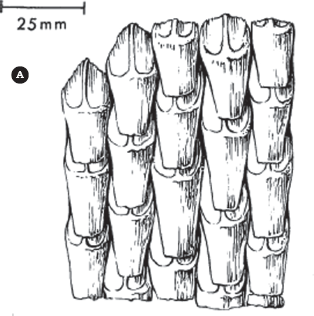
Figure 25.5
Dental battery and jaw mechanics of Triceratops: (A) external view of the teeth, which overlap like shingles and are shed as they move up and wear out; (B) cross section of the dental battery, showing how the teeth nest one inside another as they are pushed up and out as they wear down; (C) cross section of the upper and lower jaws, showing how the external surface of the lower dental battery slices and occludes against the inner surface of the upper dental battery. (Modified from Ostrom 1966)
The function of the frill has long been a source of speculation among paleontologists. The conventional story was that the frill served to protect its neck against the bite of Tyrannosaurus rex, an idea first proposed by Charles H. Sternberg in 1917 and revived many times. There is some evidence of tyrannosaur bite marks on the brow horns and cheek bones of Triceratops, but not on the frill. In some cases, horns were bitten off and regrew during the life of Triceratops. But there is no direct evidence that tyrannosaurs bit the frill in an effort to reach down and bite the neck of their prey. Many Triceratops carcasses do show bite marks and even shed teeth of tyrannosaurs, so they were definitely scavenged.
Many paleontologists believe the frill was more important for display and dominance within the species. This would explain the wide variation in shapes and sizes of frills, as well as the dramatic change in size and shape of the frill as Triceratops grew up. Juvenile Triceratops even had a small frill before they reached the age of sexual reproduction, so the frill helped aid in communication visually and in species recognition.
Juveniles and subadult Triceratops fossils are less common than adults but have been studied. The smallest babies known were only 38 centimeters (15 inches) long. As they grew up, the bones around the skull remodeled dramatically, and the horns enlarged, changed shape, and became more hollow. In 2009, at the Society of Vertebrate Paleontology meeting in Bristol, England, John Scannella and Jack Horner discussed Marsh’s 1881 genus Torosaurus (also found by Hatcher in the Lance Formation), which has the longest frill of all (figure 25.6). It also had large holes in the frill, a feature found in many other adult ceratopsians. Scanella and Horner argued that Torosaurus was a very mature example of Triceratops and that the rest of the skulls referred to Triceratops were less mature adults and subadults. If their interpretation is true, Torosaurus would just be a junior synonym of Triceratops.
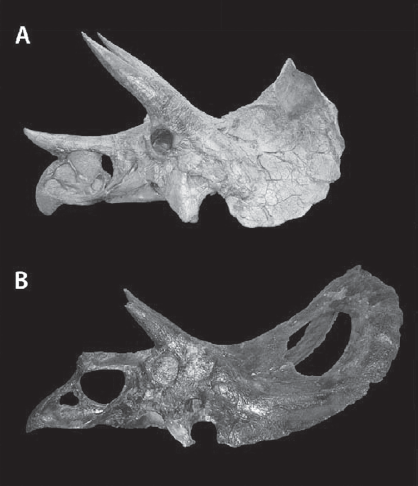
Figure 25.6
Comparison of the skull of Triceratops and Torosaurus. (Courtesy of Wikimedia Commons)
The media got this claim completely backward, and many reported that the name Triceratops was no longer valid, which caused unnecessary panic in the public arena. To be clear, if they are the same animal, then Torosaurus is no longer valid because it was named later. However, a study by Nick Longrich and Daniel Field looked at 35 skulls of Triceratops and Torosaurus and found very old skulls that still had the Triceratops frill, and less mature skulls that were clearly Torosaurus. Currently, the evidence seems to be against the idea that the two genera are the same animal representing different growth stages.
Triceratops was never found in large herd assemblages like Centrosaurus. Although they were among the most common dinosaurs of the latest Cretaceous, they apparently lived in small family groups or were solitary. There is evidence of combat between adult Triceratops. A study of skulls showed that about 14 percent had some damage from intraspecific combat, although this is low compared to other ceratopsians. There is little evidence, however, that Triceratops engaged in direct head-to-head jousting. We find, at most, one or two wounds caused by the horns puncturing the face of their opponents. Based on injuries the skull and face described by Andy Farke, it is more likely that they engaged in head-to-head wrestling.
Triceratops was clearly quadrupedal, with four sturdy legs tipped with short hooves. However, most of the early reconstructions were based on the “sprawling lizard” way of visualizing dinosaurs with their front limbs bent in a crouch (see figure 25.3C) like a crocodile or lizard, and with their tails dragging on the ground. More recent reconstructions show the limbs more upright beneath the body and only slightly flexed, and their tails held straight out (figure 25.3D). This is confirmed by trackways, which show their footprints much closer together than they would be if their front legs splayed to the side, and no tail drag marks have been found. Their hands did not have the ability to rotate to allow their fingers to face forward, unlike other quadrupeds such as stegosaurs and sauropods. Instead, Triceratops walked with most of their fingers pointing outward to the side and front. Their hands had three large functional fingers, with only vestigial remnants of the ring finger and pinky.
Triceratops has been one of the most well-known and popular dinosaurs since skeletons were first mounted in the American Museum in the early twentieth century (figure 25.3C). They were first reconstructed by legendary paleoartist Charles R. Knight, who made them look more lizard-like with sprawling forelimbs and dragging tail, consistent with the understanding at the time. Another famous 1942 mural by Knight showed Triceratops in combat with T. rex. These images influenced the portrayal of Triceratops in almost every medium for decades, especially in children’s dinosaur books and movies and TV shows, such as Walt Disney’s 1940 movie Fantasia. The heroine of the Land Before Time cartoon series for kids is the stubborn baby Triceratops named “Cera.” Triceratops has even made an appearance in recent blockbuster dinosaur media: Walking with Dinosaurs, Jurassic Park (both the novel and the 1993 movie), Jurassic Park: The Lost World, Jurassic Park III, and Jurassic World.
THE HORNED DINOSAUR RADIATION
Triceratops and Protoceratops and Psittacosaurus were part of a huge Late Jurassic through Late Cretaceous radiation of horned dinosaurs. Currently, more than 77 genera are recognized in the group (figures 25.7 and 25.8). Not only were they very diverse, but many of them were extremely abundant. A high percentage of the specimens from the Lower Cretaceous of China and Mongolia are Psittacosaurus, whereas Protoceratops dominated the Djadokhta Formation, and Triceratops makes up five-sixths of the dinosaurs recovered from the Lance and Hell Creek formations. Some, like Centrosaurus, were almost certainly herding animals, but others, like Triceratops, were apparently loners. As the most common large herbivores through much of the Cretaceous, they must have been important prey for large predators such as the tyrannosaurs.
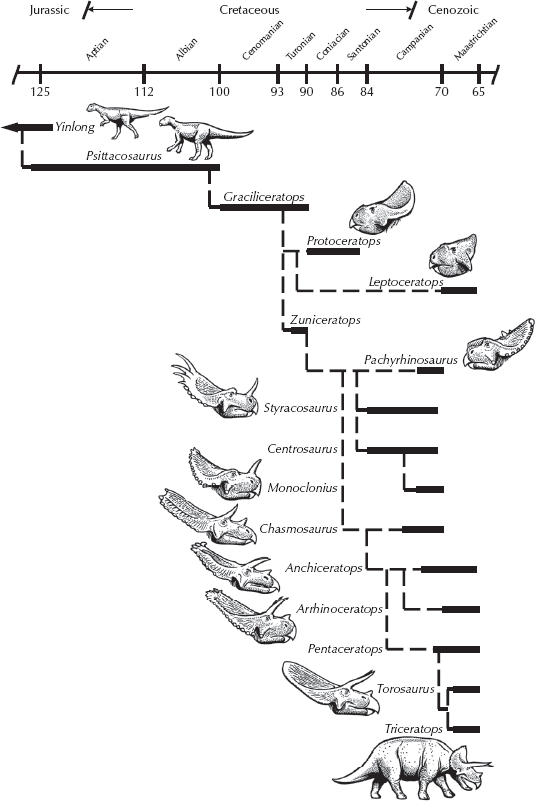
Figure 25.7
Family tree of ceratopsians. (Drawing by Carl Buell, based on several sources)
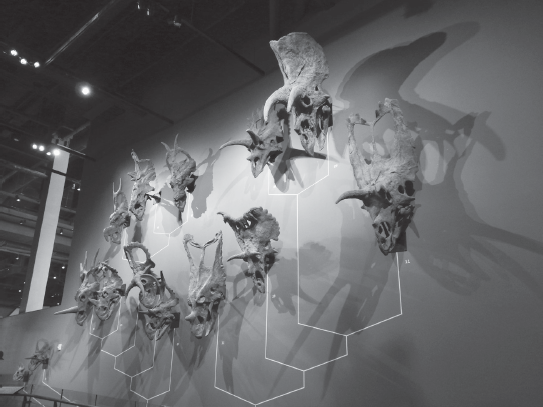
Figure 25.8
The “wall of skulls” family tree of ceratopsians at the Utah Museum of Natural History in Salt Lake City. The right hand branch (numbers 08–12) shows the chasmosaurines. The large skull on the upper right (number 11) is Coahuilaceratops magnacuerna. The two large skulls above it and to the left are (08) Anchiceratops ornatus and (09) Triceratops horridus. Number 10 is Kosmoceratops richardsoni, and 12 is Chasmosaurus belli. The branch on the left shows centrosaurines. In the top row on the left are (left to right) Einiosaurus procurvicornis, Pachyrhinosaurus lakustai, and Achelousaurus horneri. In the bottom row on the left (04–07) are (left to right) Styracosaurus albertensis, Centrosaurus apertus, Nasutoceratops titusi, and Diabloceratops eatoni. In the lower left corner are basal ceratopsians Protoceratops and Zuniceratops. (Photograph by the author)
Beginning in the Late Jurassic with Yinlong, Chaoyangsaurus, and Xuanhuaceratops from China, ceratopsians became more common and diverse in the Early Cretaceous with Psittacosaurus and numerous other genera (chapter 24), almost all restricted to Asia until the very end of the Early Cretaceous. In the early Late Cretaceous, Protoceratopsidae were in Asia, and Zuniceratops and the Leptoceratopsidae were typical of North America. By the middle Late Cretaceous, ceratopsians apparently vanished from their original homeland in Asia, but they became increasingly more diverse and common in North America. During this last great evolutionary flowering of the group, bizarre and elaborate combinations of horns, frills, and spikes increased on various parts of the skull (figures 25.7 and 25.8). One group, the Centrosaurinae, include taxa with a single nose horn, no brow horns, and a broad frill with various ornamentations on its edges, like the spiked frill of Styracosaurus, or the pair of “devil horns” on Diabloceratops, or the blunt thick boss of bone instead of a nose horn on Pachyrhinosaurus (star of the CG movie Walking with Dinosaurs) and Einiosaurus. The other group, the Chasmosaurinae, include genera with prominent brow horns and long frills with few or no spikes or other ornamentation on the edge of the frill. These include not only the familiar genera Triceratops and Torosaurus but also the triangular-frilled Pentaceratops and the bizarre-looking Medusaceratops and Mojoceratops.
Although the ceratopsians were primarily Asian and North American, a handful are from Europe, including Ajkaceratops from Hungary, Craspedodon teeth from Belgium, and a possible leptoceratopsid from Sweden. Claims for possible ceratopsians have been made on other continents as well. The Australian genus Serendipaceratops is known only from an isolated lower arm bone; it is not certain that it is from a true ceratopsian, and if so, to what ceratopsian group it belonged. Notoceratops from Argentina was based on a single toothless jaw that has since been lost.
At the peak of their success, Triceratops and a few other genera were among the last nonbird dinosaurs still around when the Cretaceous came to an end 66 million years ago. Triceratops bones can be tracked to within a meter or so of sediment before the boundary itself. The media gives the oversimplified and incorrect impression that the extinction of the nonbird dinosaurs was simply due to the impact of an asteroid in Yucatán. However, for the past 39 years, strong evidence suggests that huge volcanic eruptions, the Deccan lavas of Pakistan and western India, were changing the climate well before the rock from space hit Earth. Among paleontologists (especially vertebrate paleontologists), the asteroid impact extinction hypothesis is not very popular. Most view the complex biological signals (such as the near total survival of crocodilians, frogs, salamanders, and many turtles through the extinction) as evidence that the event was much more complex than the media and the general public think it was. To learn more about this evidence, I encourage you to read my book, The Story of the Earth in 25 Rocks (especially chapter 20).
FOR FURTHER READING
Brinkman, Paul D. The Second Jurassic Dinosaur Rush: Museums and Paleontology at the Turn of the Twentieth Century. Chicago: University of Chicago Press, 2010.
Colbert, Edwin. Men and Dinosaurs: The Search in the Field and in the Laboratory. New York: Dutton, 1968.
Dingus, Lowell. King of the Dinosaur Hunters: The Life of John Bell Hatcher and the Discoveries that Shaped Paleontology. New York: Pegasus, 2018.
Dingus, Lowell, and Mark A. Norell. Barnum Brown: The Man Who Discovered Tyrannosaurus Rex. Berkeley: University of California Press, 2010.
Dodson, Peter. The Horned Dinosaurs. Princeton, N.J.: Princeton University Press, 1996.
Dodson, Peter, Catherine A. Forster, and Scott D. Sampson. “Ceratopsidae.”In The Dinosauria, 2nd ed., ed. David B. Weishampel, Peter Dodson, and Halszka Osmólska, 494–515. Berkeley: University of California Press, 2004.
Farlow, James, and M. K. Brett-Surman. The Complete Dinosaur. Bloomington: Indiana University Press, 1999.
Fastovsky, David, and David Weishampel. Dinosaurs: A Concise Natural History, 3rd ed. Cambridge: Cambridge University Press, 2016.
Hatcher, John Bell, Othniel Charles Marsh, and Richard Swann Lull. The Ceratopsia. Washington, D.C.: Government Printing Office, 1907.
Holtz, Thomas R., Jr. Dinosaurs: The Most Complete, Up-to-Date Encyclopedia for Dinosaur Lovers of All Ages. New York: Random House, 2011.
Lull, Richard Swann. “A Revision of the Ceratopsia or Horned Dinosaurs.” Memoirs of the Peabody Museum of Natural History 3, no. 3 (1933): 1–175.
Naish, Darren. The Great Dinosaur Discoveries. Berkeley: University of California Press, 2009.
Naish, Darren, and Paul M. Barrett. Dinosaurs: How They Lived and Evolved. Washington, D.C.: Smithsonian Books, 2016.
Ostrom, John H. “Functional Morphology and Evolution of the Ceratopsian Dinosaurs.” Evolution 20, no. 3 (1966): 290–308.
Simpson, George Gaylord. Discoverers of the Lost World. New Haven, Conn.: Yale University Press, 1984.
Spaulding, David A. E. Dinosaur Hunters: Eccentric Amateurs and Obsessed Professionals. Rocklin, Calif.: Prima, 1993.

